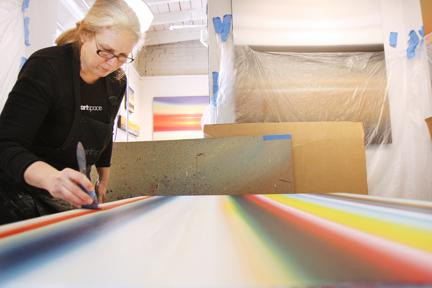From painter Jerry Mulligan in An American in Paris to filmmaker Mark Cohen in Rent, there have been many depictions of the “starving artist” lifestyle. Mulligan and Cohen often went without adequate food and shelter to practice and perfect their craft. And there was the chance that their work might go unnoticed.
Downtown Raleigh’s Artspace, located at 201 E. Davie St., is a haven for emerging artists. Artspace operates under the open-studio system, where artists work in their designated studios which are open to the public during business hours and on the first Friday night of every month.
Paris Alexander, a sculptor who works in stone, came to Artspace about 12 years ago looking for fellow artists and a studio space. He put his name in to join and was accepted. Alexander said he has always been interested in art and had always wanted to pursue it as a career.
“Sculpture is the ultimate goal, and everyone else is frustrated sculptors,” Alexander said, citing the example of painters building up their paint to make it appear more realistic.
Alexander was initially interested in sculpture when he was little, making things that his older brothers would eventually use as targets for BB gun practice. He first worked in wood, but was drawn to stone because of its ability to be displayed in large public spaces.
“Nothing lasts as long as a piece of stone. It’s a balance, being a permanent monument and an antithesis to death,” Alexander said.
In college, Alexander did not find anyone teaching stone sculpture, so he taught himself using library books about the stone carving revival of the 1920s and 1930s.
For Alexander, the greatest sacrifice has been financial. Prior to being a full-time artist, he used his undergraduate biology degree to work in chemotherapy research at Duke. After both working and going to school full-time, Alexander began thinking of what he wanted to do. When he decided to become a full-time artist, he sold everything he had and moved in a warehouse studio to live and work.
Alexander said that being a full-time artist is a large monetary commitment, and that he learned to budget out his money early on. “You have to treat it like a small business. Know that you won’t make money for the first two to three years, and you have to make a certain amount to break even,” he said.
Mixed-media artist Melinda Fine moved in mid-December 2008, and said she expects to work at Artspace for the entire year. She shares her studio with a fellow artist, a painter. Fine deals mainly with typography, which stems from her time studying graphic design at the College of Design, and incorporates other materials into her work. One method Fine uses involves layering different mediums. She lays the type on paper that has been prepared with gesso, and applies acrylic or oil pastel over it. Fine’s work deals mainly with describing the space between emotion and expression, bringing in the typography for symbolizing the expression of articulating thoughts.
Fine said she initially came to Artspace to find community ties, since it is easy to become isolated as an artist. With Artspace being completely devoted to art, Fine said that going to her studio there formalized the entire process.
“When your studio is in your house, it’s easy to be distracted and you can do everything but work,” Fine said.
She said that she works more efficiently and creates more at her Artspace studio.
Fine’s educational background includes degrees in English, psychology and creative writing. She taught graphic design and typography at Meredith College before coming to Artspace. Fine is currently still doing free-lance work while making the transition to becoming a full-time artist.
Painter Linda Ruth Dickinson has been a member of Artspace since 1990, and has been a full-time artist for more than 20 years. Dickinson said being an artist runs in ther family — her grandmother was an artist in the 1930s in Chicago.
Born and raised in Taiwan until the age of 18, Dickinson said, “My aesthetic influence was informed by Chinese culture, and I saw Western artists later. I was influenced by calligraphy, architecture, silks and brocades.”
Dickinson is mostly known for her work of horizon-scapes, which she enjoys making because she wants create broad areas of color.
“The dialogue between heaven and earth is a very Asian concept, with the division in the center being the horizon line,” Dickinson said.
Dickinson’s paint strokes are influenced by the strokes of Chinese calligraphy. She moves her brush as she saw men move their brushes while writing out scriptures for Chinese New Year banners.
On sacrificing for her art, Dickinson said, “You give up a lot, but you gain a lot. One thing you give up is your health because you’re devoting all your time to your craft.”
Dickinson solved this problem by deciding to stand up when she paints, and painting large canvases to involve the entire body. Dickinson paints with her canvas laid out on a table in front of her so that she may move around while working.
The current economic climate has been affecting the business side of art. Alexander said he lost three commissions, and Fine said that many patrons do not want to make extreme purchases right now.
Dickinson said with the recession, business has lessened a bit, but she is still able to make a living, and she is sure that it will cycle through.
“2008 was quieter, but January was good. I think we’re seeing a turnaround, so I’m hopeful,” she said.








